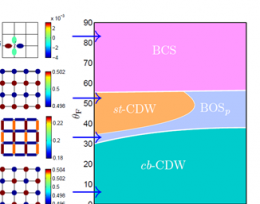Atomtronics: A new phase

Just as NASA engineers test new rocket designs in computer studies before committing themselves to full prototypes, so physicists will often model matter under various circumstances to see whether something new appears. This is especially true of atomtronics, a relatively new science devoted to creating artificial tailored materials consisting of neutral atoms held in an array with laser beams, or atoms moving along a desired track under electric or magnetic influence. A new study* shows how a simple "joystick" consisting of an adjustable magnetic field can create several new phases of atomtronic matter, several of them never seen before. Charles Clark, Co-Director of the Joint Quantum Institute will report the results at the meeting of the American Association for the Advancement of Science (AAAS) in Vancouver.
One of the attractions of atomtronics is that the properties of electrons moving through solid state materials can often be mimicked using atoms operating under highly controlled circumstances. Why not just study electrons directly? Because in atomtronics the forces among the atoms can be controlled; you can't do that as well with electrons in solids. That is, atoms can be induced to interact via a force that can be dialed up or down, exploiting the large magnetic dipole moment of some atoms, such as dysprosium-161.
Clark will describe theoretical work carried out with colleagues at George Mason University, the University of Hamburg, Germany and the University of California, Riverside. Together they have studied what happens when ultracold highly magnetic atoms are held in an optical lattice and subjected to an external magnetic field, which can be steered in various directions. This field tugs on the atom-sized magnets and, along with the direction of the field itself, leave the atoms standing upright or pulled over on their sides at various inclinations described in the figure by the angles phi and theta. In this way, the researcher can tune the interaction---force on demand.
The atoms don't just stay put as they are being jerked around. They disport themselves into patterns. Each pattern can be considered a different phase of atomtronic matter. And just as water molecules can exist in phases---ice, water, steam---depending on how a joystick that controls temperature and pressure is deployed, so the magnetic atoms sort themselves into numerous phases depending on the magnetic joystick controlling the strength and orientation of the applied magnetic field.
The atom patterns can be mapped on a phase diagram where the x and y axis describe various values of the joystick orientation. One phase is labeled cb-CDW (the turquoise part), meaning that the atoms in the optical lattice come into a checkerboard pattern (cb) as electrons do in a solid orient themselves via a so-called "charge density wave" (CDW), in analogy with a collective state of electrons in metals that is being explored as an alternative vehicle for data encoding . In the small drawing to the left the red dots represent a greater chance that an atom will be in that spot while blue dots represent a lesser chance that an atom will be there.
Another phase (the orange part) consists of atoms preferentially patterned in stripes (st). A third phase is labeled BCS. Here, analogous to the pairs of electrons in superconductors (as described by the Bardeen-Cooper-Schrieffer theory), atoms weakly pair up via long-range forces across several atomic spacings.
Two other phases seen in the study were totally unexpected. These consist of pairs---an atom yoked with a neighboring vacancy---distributing themselves in a checkerboard or striped pattern. In other words, if such a pair finds itself at one place in the lattice, another pair might be more or less likely to be in a neighboring double slot. The authors call this new phase a "bond-order solid" (BOS) since in a sense the bonds between the atom-vacancy couplets seem to be forming the patterns rather than the atoms themselves. Bond-order phases have been conjectured previously in idealized one-dimensional models, but this is the first report of their presence in a realizable physical system.
These phases are associated with the presence of strong long-range dipole interactions between ultracold atoms, a feature that does not exist for electrons in solids or in the first generation of ultracold atomic and molecular systems. Recent experimental developments show prospects for implementing ultracold dipole fermion systems in the laboratory.
Satyan Bhongale (George Mason University), the lead author of this work, says, "As physicists we like to classify states of matter. Low-temperature electronic systems are very complicated and hard to control or observe in detail. Atomtronic systems are subject to exquisite control and characterization, providing direct access and a clear insight into novel phases of matter.
More information: (*) "Bond order solid of two-dimensional dipolar fermions," S. G. Bhongale, L. Mathey, S.-W. Tsai, C. W. Clark, and E. Zhao, arxiv.org/abs/1111.2873 (Physical Review Letters, in press)
Journal information: Physical Review Letters
Provided by Joint Quantum Institute
















